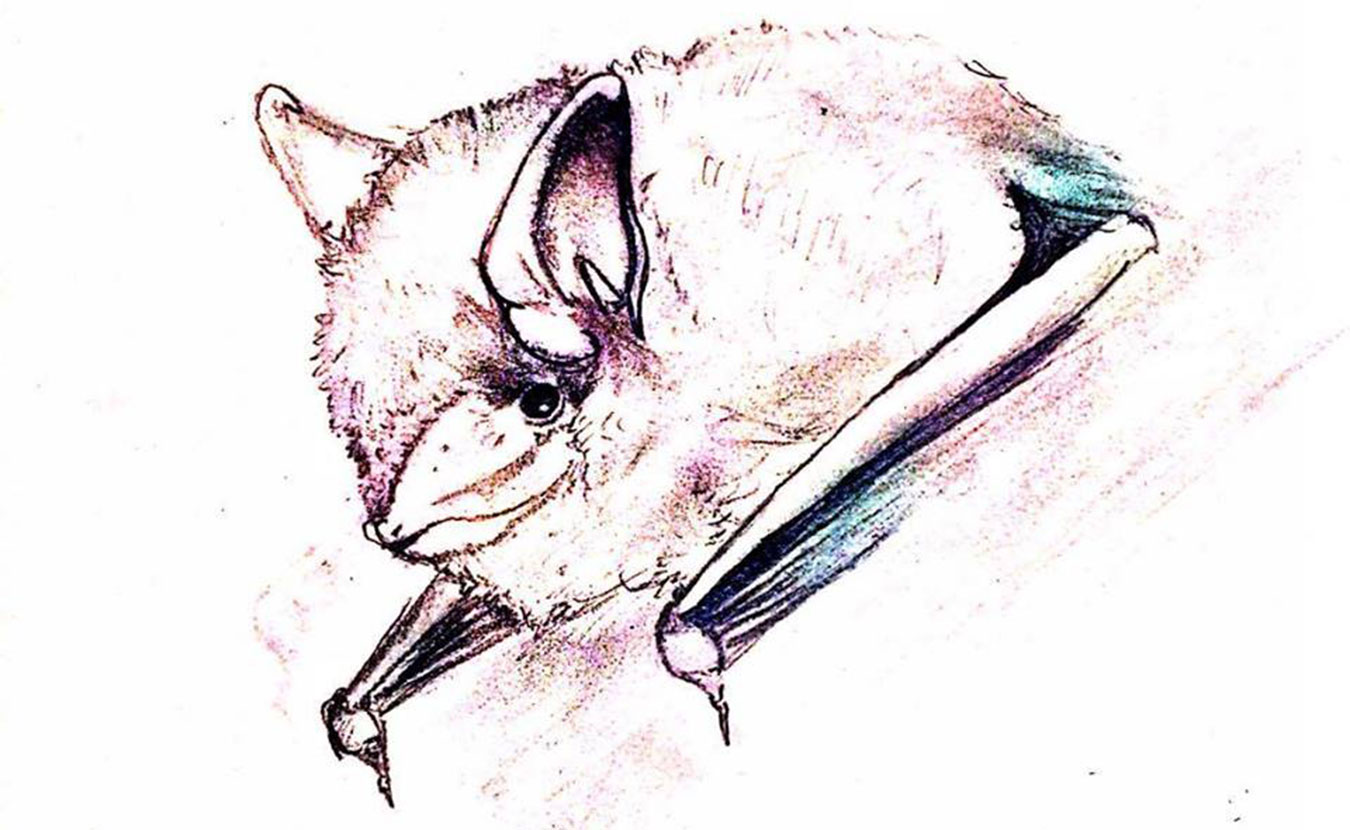Autumn in southern Indiana is filled with natural wonders. The sprawling hills are dappled with hues of red, yellow, and orange. White-tailed deer wander through some of the most expansive continuous hardwood forests in the Midwest. Those forests are teeming with the sounds of insects and birds, and, on warm nights, the soft beating of bat wings. As many of us are unpacking our favorite fall jackets, bats are busy preparing themselves for breeding, migrating, and, for many, seeking shelter for a long hiatus underground in mines or caves. Though we may not see bats very often, the streams, extensive forests, barns, caves, and croplands offer a refuge to thousands of native flying mammals throughout the year.

Most people don’t see bats, such as this big brown bat, up close. | Photo by April McKay
There are ten different species of bats found in Indiana, all of which are insectivorous and often prey upon flying insects such as mosquitoes and agricultural pests. Each of these bat species is unique and plays its own specific role in maintaining the diverse ecosystems of southern Indiana. However, most people rarely see these animals up close. One may catch a glimpse of them for a moment, flying by a forest edge or over water before night settles in or perhaps roosting in a barn or a cave. The few who do see bats up close generally see them when they fly too close and startle an unsuspecting walker-by, or when they end up in places where they aren’t welcome, such as your home or office.
Bats, of course, prefer to be left alone and live their lives in peace. They are no more interested in playing out vampire-movie-inspired nightmares by getting stuck in your hair or sucking your blood than a Labrador retriever might be. The power of flight and a preference for the night have kept these animals in the shadows, making it all too easy for fear to grow from those few instances that bats reveal themselves to people.
Bats make great neighbors, however. They support a healthy ecosystem, which benefits us all. The Indiana bat, a federally endangered species that can still be found throughout southern Indiana, will eat as much as half of its body weight in flying insects each night. Plus, it is not uncommon for reproductive females of many bat species to consume their entire weight in insects nightly. One study found that bats are worth approximately $3.7 billion to U.S. agriculture from the pests that they devour each year. Furthermore, bats that roost in caves offer vital nutrients to the cave environment in the form of their guano (bat excrement is often used as fertilizer).

There are 1,300-plus known species of bats, such as this tricolored bat, which make up one-quarter of the number of all known mammal species. | Photo by Travis Brown
Unfortunately, bats in Indiana are facing a myriad of dangers. Of the ten species regularly found in Indiana, two are federally endangered, one is federally threatened, and all but one species are considered of special concern or endangered at the state level. Habitat loss and human disturbance have been damaging bat populations for decades, but, more recently, bats are up against a new threat. An invasive white fungus that thrives in cave environments was found growing on the face and wing membranes of bats in a cave in New York during winter 2007. This fungus, Pseudogymnoascus destructans, or pd, is native to Europe and was likely brought to the U.S. on caving equipment. Pd grows on the soft tissues of bats while they are in torpor (a reduced metabolic state similar to hibernation) in caves and mines and causes White Nose Syndrome, or WNS. The disease often arouses the bats from torpor while roosting in caves during the winter. Any amount of disturbance during this sensitive period of the year draws away precious energy meant to help bats survive the winter underground. WNS has had a devastating impact on many bat populations in the eastern U.S. and Canada, and it continues to spread at an alarming rate.

One major threat to bats is an invasive white fungus that thrives in cave environments and grows on the face and wing membranes of bats, causing White Nose Syndrome. | Photo by Price Sewell
WNS was first detected in Indiana caves in 2011, and, since then, the Indiana bat (Myotis sodalis) populations in the state have been reduced by 27 percent. The population of the Indiana bat’s close relative, the little brown bat (Myotis lucifugus), has plummeted 90 percent. With some of the country’s largest Indiana bat hibernacula (their winter roosting and resting places) in southern Indiana, Hoosiers are at risk of losing some of their most valuable native wildlife if bat conservation is not taken seriously. Unfortunately, most folks haven’t had the opportunity to see how charming and impressive bats are, and thus are not likely to consider taking steps to help them.
Bat biologists at Indiana State University (ISU) in Terre Haute have set out to create such an opportunity. This year, the Center for Bat Research, Outreach and Conservation will host the 11th annual Indiana Bat Festival in the Science Building on the ISU campus on September 16 from 10 a.m. to 4 p.m. The free, family-friendly event will include all manner of bat-related indoor activities, such as a live animal show, face painting, informative talks, as well as a bake sale and a silent auction to raise money for bat conservation. The Organization for Bat Conservation will even have live fruit bats and insectivorous bats as part of an educational program. Then from 6 to 10 p.m., the festival will resume at Dobb’s Park where there will be a bat-themed obstacle course, a live raptor show, and a chance to listen for bats using acoustic detectors at sunset.
Dr. Joy O’Keefe, director of the Center for Bat Research, Outreach and Conservation and associate professor of the biology department at ISU, has worked with bats since 2000. She is a prominent figure in the bat research community and has made a huge impact in bat conservation in Indiana and throughout the eastern U.S. O’Keefe became involved with the festival in 2010 and has watched the event evolve into a more hands-on approach to educating people. Her hope is that people who attend the event will take time to learn more about bats and then inform others.
“Bats are often feared,” O’Keefe says, “but that is mainly because they’ve been so maligned by Hollywood. Bats are amazing mammals — the only mammals capable of true-powered flight, extremely diverse across the taxonomic order, and incredibly long-lived for their size. Furthermore, they benefit us by consuming pestilent insects and, in the tropics, by pollinating important plants and dispersing seeds. Bats deserve our respect and admiration!”
Plenty of mammals appear as if they fly, but only bats can propel themselves up and stay adrift on the wing. Many species of bats rely on echolocation (using sound and the way it reflects off of objects) rather than sight to forage for food and navigate the world. The 1,300-plus known species of bats make up one-quarter of the number of all known mammal species. Of those species, many are insectivores that help control pests, but some bats prey on birds, frogs, and even fish. Vampire bats do exist, but only three of all bat species rely on blood meals, and only one of those three prefers mammals (even then, cows and horses are their usual preference). And then there are some species that feed exclusively on fruit or the nectar of plants — they’re vegans!

April McKay holds an Indiana bat, whose in-state population has dropped 27 percent since 2011. | Photo by Travis Brown
Bats are a remarkably diverse group in terms of size as well. Some bats have wingspans as wide as the average woman is tall, and some bats are so small that they weigh less than a penny. Longevity is also an impressive trait in this group of animals. A male Brandt’s bat (Myotis brandti) was found in Siberia that lived to be 41 years old in the wild. This is an earth-shatteringly long life for a mammal that is half the size of the average field mouse (whose lifespan is about a year at best). To put that in perspective, the average life expectancy of men living in East Siberia is 55 years old.
The Indiana Bat Festival offers many resources for learning more about bats, as well as on how to lend a hand to bats and be advocates for their conservation. O’Keefe has some recommendations for people looking for everyday ways to help, as well as how to better coexist with bats.

The little brown bat’s Indiana population has dropped 90 percent since 2011. | Photo by April McKay
“We often hear about bats getting into people’s houses, which they seek out when natural roosts [large, hollow trees] are lacking,” O’Keefe says. “Providing high-quality, artificial roosts is a way to mitigate for the lack of natural habitat.”
One of the easiest and more fun ways to help bats is to supply them with artificial roosts, such as a wooden home called a bat box. Many folks at the festival will offer information about where to buy bat boxes — or even how to build one — and the variety of places to install them.
“People can help bats by being more considerate of their natural environment,” O’Keefe says. “Taking actions to promote healthy forests and other natural areas and maintaining clean waterways will benefit bats and many other critters, too. In urban areas, people can help bats by providing artificial habitat for them.”
You can also help bats by making a donation to the Indiana Department of Natural Resources Nongame Fund, which will help improve habitat and support citizen science projects. When we do our part to protect natural resources such as healthy forests, water, air, and other wild spaces, this gives wildlife a fighting chance at supporting themselves and keep ecosystems intact and balanced.
In this era, it is more important than ever to be informed about our natural resources — and to be constantly celebrating them and working toward preserving them. Bats and their place in the world may appear to be a small issue in comparison to the endless list of things we all worry about every day. But when we protect animals such as bats, the natural world is that much closer to taking care of itself. Moreover, a world where bats don’t fly among us, where no one stops to watch them with wonder and respect, is a world robbed of mystery — and aswarm with insects.


